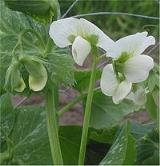
Pisum
Encyclopedia
Pisum is a genus of the family Fabaceae
, native to southwest Asia
and northeast Africa
. It contains one to five species, depending on taxonomic interpretation; the International Legume Database (ILDIS) accepts three species, one with two subspecies http://www.ildis.org/LegumeWeb/6.00/names/npall/npall_567.shtml:
Pisum sativum (the field or garden pea), is domesticated and is a major human food crop.
Pisum species are used as food plants by the larva
e of some Lepidoptera
species including Bucculatrix pyrivorella
, Cabbage Moth
, Common Swift
, Ghost Moth
, Hypercompe indecisa
, The Nutmeg
, Setaceous Hebrew Character
and Turnip Moth
.
The Pisum sativum flower has 5 sepals (fused), 5 petals, 10 stamens (9 fused in a staminal tube and 1 stamen is free) and 1 subsessil carpel.
Fabaceae
The Fabaceae or Leguminosae, commonly known as the legume, pea, or bean family, is a large and economically important family of flowering plants. The group is the third largest land plant family, behind only the Orchidaceae and Asteraceae, with 730 genera and over 19,400 species...
, native to southwest Asia
Asia
Asia is the world's largest and most populous continent, located primarily in the eastern and northern hemispheres. It covers 8.7% of the Earth's total surface area and with approximately 3.879 billion people, it hosts 60% of the world's current human population...
and northeast Africa
Africa
Africa is the world's second largest and second most populous continent, after Asia. At about 30.2 million km² including adjacent islands, it covers 6% of the Earth's total surface area and 20.4% of the total land area...
. It contains one to five species, depending on taxonomic interpretation; the International Legume Database (ILDIS) accepts three species, one with two subspecies http://www.ildis.org/LegumeWeb/6.00/names/npall/npall_567.shtml:
- Pisum abyssinicum (syn. P. sativum subsp. abyssinicum)
- Pisum fulvum
- Pisum sativumPeaA pea is most commonly the small spherical seed or the seed-pod of the pod fruit Pisum sativum. Each pod contains several peas. Peapods are botanically a fruit, since they contain seeds developed from the ovary of a flower. However, peas are considered to be a vegetable in cooking...
- PeaPeaA pea is most commonly the small spherical seed or the seed-pod of the pod fruit Pisum sativum. Each pod contains several peas. Peapods are botanically a fruit, since they contain seeds developed from the ovary of a flower. However, peas are considered to be a vegetable in cooking...
- Pisum sativum subsp. elatius (syn. P. elatius, P. syriacum)
- Pisum sativum subsp. sativum
Pisum sativum (the field or garden pea), is domesticated and is a major human food crop.
Pisum species are used as food plants by the larva
Larva
A larva is a distinct juvenile form many animals undergo before metamorphosis into adults. Animals with indirect development such as insects, amphibians, or cnidarians typically have a larval phase of their life cycle...
e of some Lepidoptera
Lepidoptera
Lepidoptera is a large order of insects that includes moths and butterflies . It is one of the most widespread and widely recognizable insect orders in the world, encompassing moths and the three superfamilies of butterflies, skipper butterflies, and moth-butterflies...
species including Bucculatrix pyrivorella
Bucculatricidae
Bucculatricidae or is a family of moths. This small family has representatives in all parts of the world. Some authors place the group as a subfamily of the family Lyonetiidae....
, Cabbage Moth
Cabbage Moth
Note: the Small White species of butterfly is commonly called a "cabbage moth" in North America.The Cabbage Moth is a common European moth of the family Noctuidae....
, Common Swift
Common Swift (moth)
The Common Swift is a moth of the family Hepialidae. It was previously placed in the genus Hepialus. It is a common, often abundant European species....
, Ghost Moth
Ghost Moth
The Ghost Moth , also known as the Ghost Swift, is a moth of the family Hepialidae. It is common throughout Europe except for the far south-east...
, Hypercompe indecisa
Hypercompe
Hypercompe is a genus of moths of the family Arctiidae. There are over 80 species found throughout the Americas. Several species were formerly separated in Ecpantheria which is now regarded as a junior synonym. They are typically large moths with white forewings heavily spotted with black, and...
, The Nutmeg
Nutmeg (moth)
The nutmeg , also known as the clover cutworm, is a moth of the family Noctuidae. It is found throughout Europe although in the north of its range it is a summer migrant, not being able to survive the cold winters.This is a small to medium species with cryptically coloured forewings, varying from...
, Setaceous Hebrew Character
Setaceous Hebrew Character
The Setaceous Hebrew Character is a moth of the family Noctuidae. It is found in the Palearctic ecozone. It is a common species throughout Europe. It is also found in North America, from coast to coast across Canada and the northern United States to western Alaska. It occurs in the Rocky Mountains...
and Turnip Moth
Turnip Moth
The Turnip Moth is a moth of the family Noctuidae. It is a common European species, but it is also found in Asia and Africa, very likely having been spread by the international trade in nursery stock...
.
The Pisum sativum flower has 5 sepals (fused), 5 petals, 10 stamens (9 fused in a staminal tube and 1 stamen is free) and 1 subsessil carpel.

